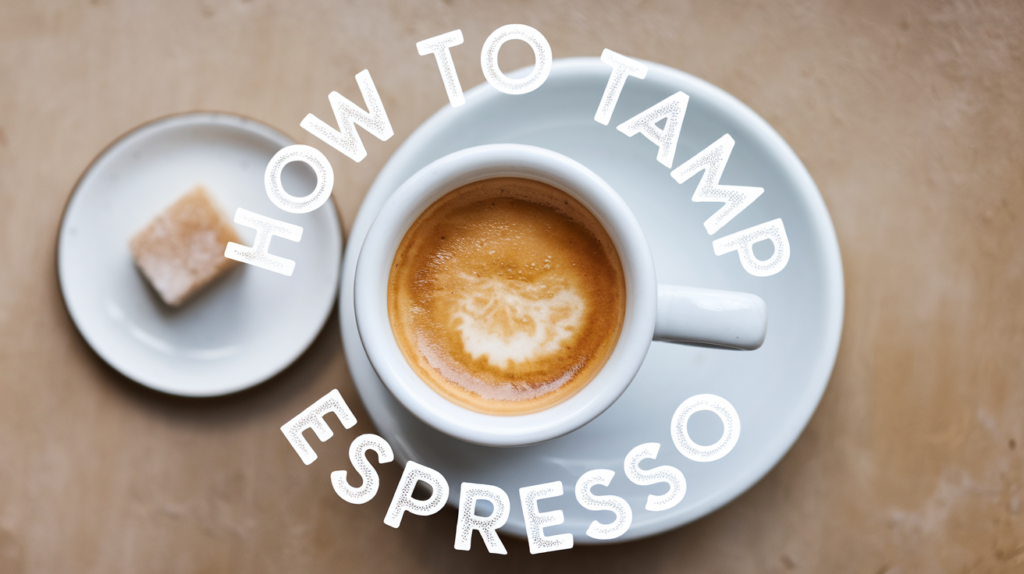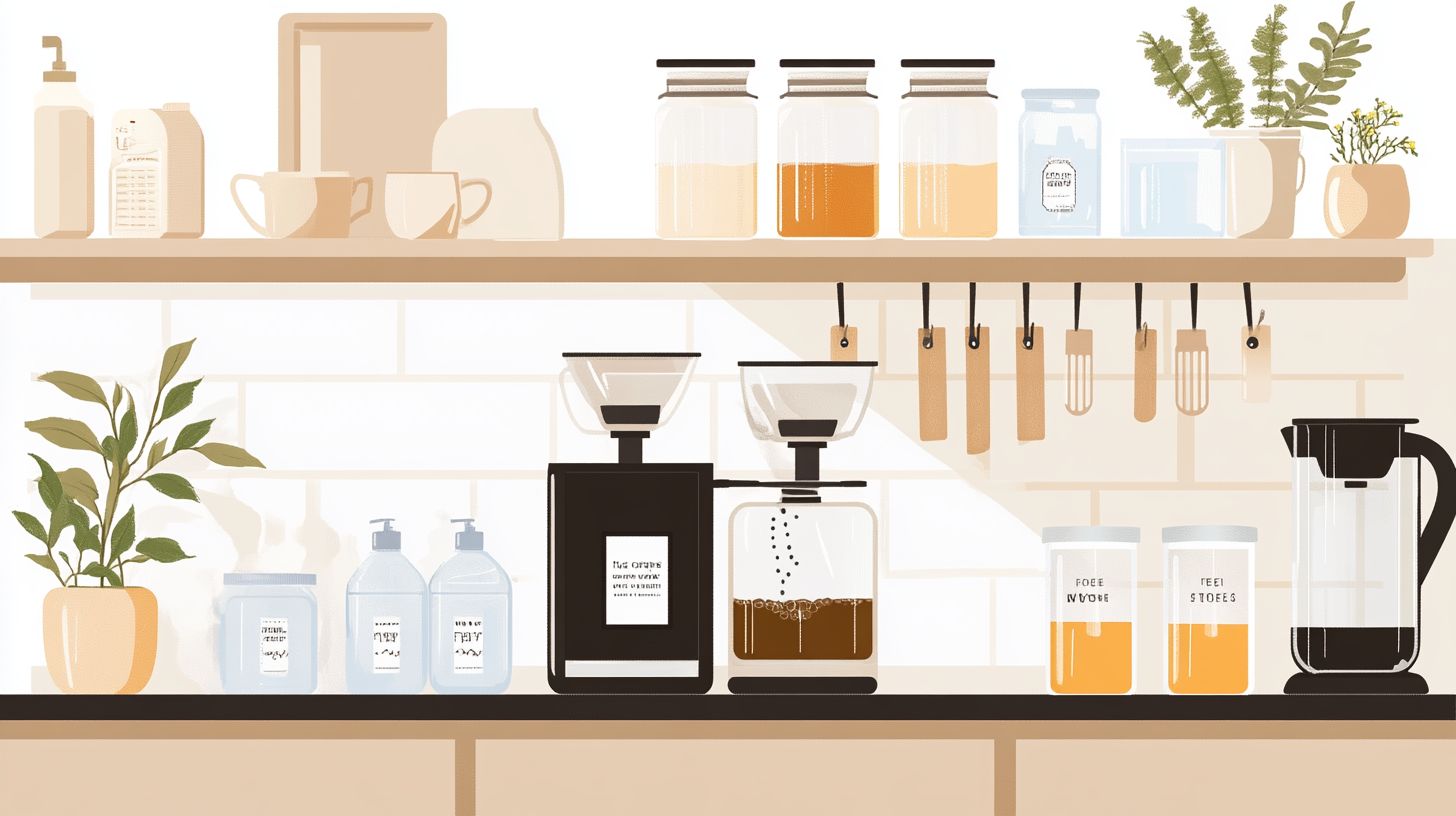Blog
How Hard to Tamp Espresso
Tamping espresso can be tricky. You might wonder how hard to press down on your coffee grounds. Too light, and your shot tastes weak. Too hard, and it’s bitter. Don’t worry – we’ve got the answers.
Did you know that proper tamping helps water flow evenly through your coffee? It’s true. This guide will show you how to tamp just right. You’ll learn the best pressure and techniques for great espresso.
Ready to perfect your shots?

What Is Espresso Tamping?
Espresso tamping is pressing coffee grounds in a portafilter. It’s a key step in making great espresso shots.
Basic Principles Of Tamping
Tamping plays a crucial role in creating excellent espresso. Press the coffee grounds evenly into the portafilter to form a flat, compact puck. Use a flat tamper and apply steady pressure, stopping when the tamper no longer moves downwards.
This indicates you’ve achieved the proper density.
Your aim is to create a smooth, level coffee bed. While pressure is important, grind size has a greater impact on flow rate. Focus on maintaining consistency in your technique. As you practise, you’ll develop a natural feel for the right amount of force to apply.
Keep in mind that tamping is just one element in the process of preparing the perfect espresso shot.
The Role Of Tamping In Extraction
Tamping plays a key role in espresso extraction. It presses the coffee grounds into a tight puck, creating resistance for the water to flow through. This resistance is necessary for proper extraction.
A well-tamped puck lets water pass evenly through all the grounds, pulling out rich flavours and oils.
Proper tamping creates even compression for good brewing. It helps create a full-bodied espresso with a rich crema on top. Without good tamping, you might end up with weak, watery coffee.
The right pressure also stops water from finding easy paths through the grounds, which can lead to poor taste.
Essential Tamping Equipment
You need a few key tools for proper espresso tamping. A flat tamper is a must – it presses the coffee evenly and stops air pockets. Get one that fits your portafilter snugly. A tamping mat gives you a stable surface to work on.
It protects your counter and helps you tamp at the right angle. Many baristas also use a distribution tool. This spreads the grounds evenly before tamping. With these basics, you’ll be set to create great espresso shots.
How Much Pressure Is Needed For Tamping Espresso?
Tamping pressure is key for great espresso. You need about 30 pounds of force for the best results.
Standard Pressure Guidelines
Espresso tamping requires a firm touch. You’ll want to press down with at least 15 pounds of force. This creates a solid coffee puck. Many professionals suggest using 20-30 pounds of pressure for the best results.
Don’t push too hard, though. You’ve reached the right density when your tamper stops moving down.
Consistent pressure is key for great espresso. Use a bathroom scale to practise feeling the right amount of force. This helps you build muscle memory. Once you’ve mastered it, you’ll tamp like a professional every time.
Keep in mind that even pressure across the whole puck is necessary for tasty shots.
Measuring Tamping Force
To gauge tamping pressure, bathroom scales can be useful. Position your portafilter on the scales and apply pressure with your tamper. Aim for 9 to 13.5 kilograms of pressure. This approach helps you develop a sense for the appropriate amount of force.
Some experts now suggest 3.6 kilograms is sufficient. Experiment with both and determine what produces the best results for your espresso.
Uniform pressure is essential for even extraction. Insufficient force results in weak shots. Excessive pressure can over-compress the grounds. Practise until you can consistently achieve your target pressure.
A level tamp is equally important as the correct force. Maintain a straight wrist and apply pressure evenly across the coffee bed.
Common Pressure Mistakes
Tamping espresso correctly is tricky. Many coffee lovers make these common pressure mistakes:
- Pressing too hard: You don’t need to use all your strength. Over-pressing can lead to slow extraction and bitter coffee.
- Uneven pressure: Tilting the tamper creates an uneven bed. This causes water to flow unevenly, resulting in poor extraction.
- Not enough pressure: Light tamping leaves air pockets. These cause water to channel through, leading to weak espresso.
- Twisting the tamper: Rotating while tamping can disrupt the coffee bed. This often results in uneven extraction and flavour.
- Inconsistent pressure: Varying your tamping force between shots affects taste. It’s hard to repeat good results without steady pressure.
- Ignoring grind size: Fine grounds need less pressure than coarse ones. Adjust your tamp based on your grind for best results.
- Tapping the portafilter: This can crack the puck. Cracks let water rush through, leading to under-extracted espresso.
- Using the wrong tamper size: A poorly fitting tamper leaves gaps. These gaps cause uneven extraction and weak crema.
Why Does Tamping Pressure Matter For Espresso?
Tamping pressure affects how your espresso tastes and looks. It changes how water flows through the coffee. Get it right, and you’ll enjoy a rich, creamy shot. Want to know more about perfecting your tamp? Keep reading!
Impact On Extraction Quality
Proper tamping affects your espresso’s taste. It creates a compact puck that water flows through evenly. This even flow extracts flavours well. Bad tamping leads to weak or bitter shots.
Your tamp pressure changes how fast water moves through the coffee. Too light, and water rushes through, making a weak drink. Too hard, and water struggles to pass, causing over-extraction.
The right pressure gives you a balanced, tasty espresso.
Relationship To Flow Rate
Flow rate links closely to tamping pressure in espresso making. Your tamp affects how water moves through the coffee. A good tamp creates just enough resistance for water to extract flavour evenly.
Too loose, and water rushes through too fast. Too tight, and it drips too slowly.
You’ll want to aim for 20-30 pounds of pressure when tamping. This helps control the flow rate for a 25-30 second shot. With practice, you’ll learn to feel the right pressure. A steady, even tamp leads to better taste and a nice crema on top of your espresso.
Effects On Taste And Crema
Tamping affects your espresso’s taste and crema. A good tamp leads to a rich, full-bodied shot with a thick crema. Poor tamping can make your espresso weak or bitter. It might even lack that lovely golden foam on top.
The right pressure helps water flow evenly through the coffee. This pulls out all the good flavours. Too little pressure and you’ll get a watery, sour drink. Too much and it’ll be over-extracted and harsh.
Aim for that sweet spot to get a smooth, balanced espresso with a creamy top.
What Are The Different Tamping Techniques?
Tamping your espresso can be done in different ways. You can try level tamping, nutating, or palm tamping to get the best shot.
Level Tamping Method
Level tamping is a key step in making great espresso. You’ll want to create a flat, even coffee bed. Start by filling your portafilter with ground coffee. Tap it gently to settle the grounds.
Then, hold your tamper with a straight wrist and 90-degree bent elbow. Press down with light, even force across the whole surface. Aim for about 30 pounds of pressure. This helps water flow evenly through the coffee puck.
A level tamp prevents channeling and uneven extraction. Keep your tamper parallel to the basket rim. Don’t twist or tilt as you press. Check that the coffee surface is smooth and flat after tamping.
If you see any gaps or unevenness, start over. With practice, you’ll develop a consistent technique for perfect espresso shots every time.
Nutating Technique
The nutating technique is a smart method for tamping espresso. You make small circular movements while pressing down on the coffee. This helps distribute the grounds evenly in the portafilter.
It may take some practice initially, but it can result in improved shots.
Experts suggest nutating creates a more uniform coffee puck. This means water flows through the coffee more evenly when brewing. The outcome? A smoother, richer espresso with better flavour.
It’s an advanced method that requires practice, but many baristas rely on it for excellent shots.
Palm Tamping Approach
Palm tamping is a quick fix for espresso making. You press your clean palm on the coffee bed. It’s not as steady as using a tamper. But it can work in a pinch. Try to push evenly across the whole coffee surface.
This helps get a uniform tamp. Even pressure is key for good espresso extraction.
For best results, use a proper tamper when you can. Palm tamping is just for emergencies. It’s harder to get the right pressure with your hand. A real tamper gives you more control.
Still, knowing this trick can save your coffee in a tight spot.
How Can Tamping Problems Be Identified?
Tamping issues can sneak up on you. Look for signs like uneven extraction or weak crema in your espresso shots.
Signs Of Under Tamping
Under tamping leaves your espresso grounds loose. You’ll spot gaps in the coffee puck. These gaps let water rush through too fast. Your brew turns out weak and watery.
Look for clumps in your grounds after tamping. If you see them, you haven’t pressed hard enough. A smooth, even surface means you’ve done it right. Aim for a firm puck that doesn’t crumble when you tap the portafilter.
Indicators Of Over-Tamping
Over-tamping your espresso can ruin your shot. You’ll spot it by a bitter taste in your cup. This happens because too much pressure squeezes out extra flavours you don’t want. Your coffee might also come out slower than usual.
If you see these signs, ease up on your tamp.
Watch out for changes in how your espresso looks and tastes. A dark, thin stream or a very slow pour points to over-tamping. Your puck might stick to the shower screen when you remove it.
If your tamper stops moving before you expect, you’ve likely reached max density. Any more force after that is too much.
Troubleshooting Common Issues
Wet coffee pucks often indicate tamping issues. Review your method first. Are you applying too much or too little pressure? Aim for 30 pounds of force. Uneven grounds can cause problems as well.
Use a distribution tool to spread coffee evenly before tamping. If issues continue, your machine may require attention. Clean the group head and check water pressure. These actions should help you resolve most common tamping problems.
Remember your tamper’s fit. It should match your portafilter size exactly. An improper fit results in uneven presses and weak shots. High-quality tools make a significant difference.
Invest in a good tamper and maintain its cleanliness. With the proper equipment and knowledge, you’ll consistently produce excellent shots.
What Equipment Helps With Consistent Tamping?
Calibrated tampers, tamping mats, and distribution tools can help you tamp espresso more consistently. These gadgets take the guesswork out of tamping and lead to better shots… Want to learn more about these helpful tools?
Calibrated Tampers
Calibrated tampers take the guesswork out of espresso making. They click when you reach the right pressure – usually 30 pounds. This helps you tamp with the same force every time. Brands like Bravo, The Force, and Push make good ones.
They cost a bit more but last long. You’ll get more even shots and better coffee with a calibrated tamper.
Tamping Mats
Tamping mats are handy tools for espresso lovers. They protect your countertop from dings and scratches. These mats also give you a stable base for even tamping. You’ll find lots of styles to suit your taste.
Some are made of rubber, others of silicone. Pick one that fits your workspace and looks good too. A good mat helps you tamp with the right pressure every time. This leads to better espresso shots.
Your coffee will taste more consistent day after day. Plus, you won’t have to worry about damaging your kitchen surfaces.
Distribution Tools
Distribution tools help you spread coffee grounds evenly. They come in many shapes, like rakes or needles. You use them before tamping to break up clumps. This creates an even flow of water through all the coffee.
The Weiss Distribution Technique (WDT) is a widely used method. It uses thin needles to stir the grounds. Some tools, like Duomo the Tamper, combine WDT with tamping. These tools are time-efficient and improve your espresso shots.
How Does Grind Size Relate To Tamping Pressure?
Grind size and tamping pressure go hand in hand. Finer grinds need less pressure, while coarser ones need more to create the right resistance for your shot.
Finding The Right Balance
Balancing tamping pressure and grind size is key for great espresso. You need about 30 lbs of force when tamping. Too little pressure leads to weak shots. Too much doesn’t hurt, as coffee has a natural limit.
The grind matters too – finer grinds need less pressure.
Your grinder settings affect how hard you tamp. Coarser grinds need more pressure to slow water flow. Finer grinds let you use less force. Play with both until you get tasty shots that pour in 25-30 seconds.
Keep notes on what works best for each coffee type you use.
Adjusting For Different Beans
Different coffee beans require varying tamping techniques. Dark roasts have a softer texture, so apply less pressure when tamping. Light roasts are harder, necessitating more pressure.
You’ll need to adjust your tamping force based on the bean type. Aim for approximately 30 pounds of pressure for dark roasts and 35 pounds for light roasts. Experiment and refine your technique until you achieve the desired flow rate.
Beans also change as they age. Fresh beans typically require less pressure compared to older ones. Monitor your shots closely and adjust your tamping pressure as needed. Your target is a 25-30 second extraction time.
If the extraction is too quick, increase your tamping pressure. If it’s too slow, reduce the pressure slightly. With practice, you’ll perfect the ideal tamping technique for each bean variety.
Coordination With Dose Weight
Dose weight and tamping pressure go hand in hand. You need to adjust your tamp based on how much coffee you use. For a standard 18g dose, aim for about 13-15 kg of pressure. If you up your dose to 20g, you’ll want to tamp a bit harder – around 18-20 kg.
This keeps the puck density consistent as you change doses.
Your grind size also affects how hard you tamp. Finer grinds need less pressure, while coarser ones need more. Play around with your grind and tamp to find the sweet spot for your beans and machine.
A scale helps you measure dose weight precisely. With practice, you’ll dial in the perfect combo of dose, grind, and tamp for tasty shots.
Conclusion
Preparing espresso requires practice. You’ll improve as you gain experience. Apply 9-14 kilograms of pressure for a well-formed coffee puck. Maintain a straight wrist to prevent strain.
Keep in mind that uniform tamping results in flavourful shots. Try these suggestions and savour your ideal espresso!
FAQs
1. How hard should I tamp my espresso?
Don’t press too hard… 30lbs of pressure is enough. That’s like pushing down with 15 pounds on your hand. More won’t help and might hurt your wrist.
2. What’s a common mistake when tamping coffee?
Twisting the tamper! This can mess up the puck shape. Just press straight down to keep the coffee even. No need to spin or twist.
3. How do I know if I’ve tamped right?
Look for a smooth, level bed of coffee. No gaps or air bubbles. The puck should be firm, like a hockey puck. If it’s too soft, tamp a bit harder next time.
4. Does the type of tamper matter?
Yes! Use a tamper that fits your portafilter basket well. It should touch all the coffee, right to the edges. This helps make sure the water goes through evenly.
5. Can I tamp too lightly?
Yep. If you tamp too light, the water might find a quick way through. This can lead to weak espresso. Aim for that 30lbs sweet spot for best results.
6. How does tamping affect my espresso shot?
Good tamping makes the coffee even and dense. This slows the water down just right. It helps you get a quality espresso with good flavour and crema.


